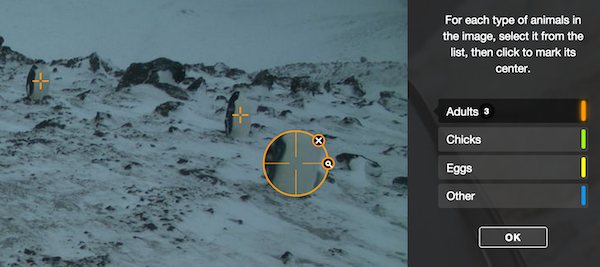I've been buried deep in working on my dissertation proposal and have been finding it…

Your Students Can Help Scientists!
The Zooniverse is a collection of web-based citizen science projects that use the efforts of volunteers to help researchers deal with the flood of data that confronts them. Anyone can participate and teachers can certainly use this with their students. Their collection of activities gives a real-world context for showing students how they can contribute to the world of science and society in general.
Projects are divided into categories: space, climate, humanities, nature, biology, and physics.

How can your students help Penguin Watch? Students simply look at pictures and click on areas to identify adult penguins, baby penguins, or penguin eggs. The data is then used by the project to improve understanding of these species. The notations students make on the images will also aid in “training” a computer to automatically recognize penguin individuals.

Some of the other projects by Zooniverse are:
- PlanetFour – Find and mark ‘fans’ and ‘blotches’ on the Martian surface to help planetary scientists identify and measure features on the surface of Mars.
- Solar Stormwatch – Spot explosions on the Sun and track them across space to Earth to help astronauts get an early warning if dangerous solar radiation is headed their way.
- Cyclone Center – Look at two satellite images and select the stronger storm and storm type (guiding questions are provided to help identify the storm type).
- Cell Slider – View pathological data and target cancer cells.
- Floating Forests – Identify kelp in underwater images.
- more…
Projects also have chats available with the scientists so you and your students can ask questions of the experts themselves.
Possible extensions:
- Have students write a reflection for a portfolio.
- Have students create a guide for identfying whatever the object was.
- Have students write a poem from the perspective of the object or the scientist.
- Have students write a children’s book about the object, including pictures. Print and bind them and donate to a library.
- Hold a Google Hangout or Skype with scientists involved with the project.
- Have a Zooniverse hour once a week and give students a choice as to which project to support. At the end of the semester, have students present to the class about what they learned, what difference they envision they have made in the world, how they might take what they have learned and use it in the future.
Whether you have students do these individually or you do as a whole-class activity with an interactive whiteboard, this activity has endless connections to expand your students’ knowledge of the world around them.
Hear an interview with one of the scientists on NPR: Researchers Enlist Internet Users To Help Monitor Penguins

This Post Has 0 Comments